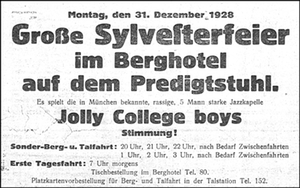The Grande Dame of the Alps
Oldest cable car in the world
The Predigtstuhlbahn in Bad Reichenhall is also affectionately called the Grand Dame of the Alps. It is the oldest of its type that has been retained in its original state and has been listed as a historic monument. From the very beginning, the Predigtstuhlbahn has been considered the model of a perfect cable car and the embodiment of elegance in cable car design. And that is still the case to a large degree today. Its monumental pylons soaring into the sky and the Mountain Restaurant as well as the top and base stations are stony witnesses of the “New Objectivity” – the brief architectural epoch that replaced the playful Art Nouveau and is seen as a partner to the Bauhaus style.

The Predigtstuhlbahn had several sponsors in the glamorous spa town of Bad Reichenhall. After World War I, hyperinflation and the loss of important customer segments, they had made it their aim to close the gap to other competing spa towns by building a cable car to the top of a mountain. In 1926 and 1927, Alois Seethaler from the Axelmannstein Hotel and Director Josef Niedermeier, responsible for spa tourism in the town, invited several specialists to Bad Reichenhall, including Alois Zuegg, the brilliant inventor of modern cable car technology. The Predigtstuhlbahn is still benefiting from his vast experience today because Zuegg was never satisfied and kept looking for improvements. His stated claim was to realise the best and most efficient concept because “in view of the demanding spa public of Bad Reichenhall there must be no lack of elegance and comfort.”

In the 1920s, engineer Alois Zuegg and manufacturer Adolf Bleichert, then heading the world’s largest cable car production, perfected cable car engineering through several innovations combined in the “Bleichert-Zuegg System”. In building the Predigtstuhlbahn, they produced a masterpiece, aided by the fact that they succeeded in bringing on board Wilhelm Kahrs, director of the Hochtief construction company, as the architect for the buildings. Incidentally, almost simultaneously Kahrs built the Ammerbrücke Echelsbach, which was the Melan arch bridge with the widest span in the world at the time. The planning for the characteristic monumental pylons was performed by the engineering office of Otto Streck and Alfred Zenns, which collaborated on the Echelsbach Bridge as well.
The Predigtstuhlbahn started operation on 1 July 1928, and the mood was euphoric. For Bad Reichenhall, the cable car was the epitome of the economic recovery. The world press praised its speed, lack of noise and safety. These attributes are still valid today. The Predigtstuhl became the meeting place of the upper echelons of society.